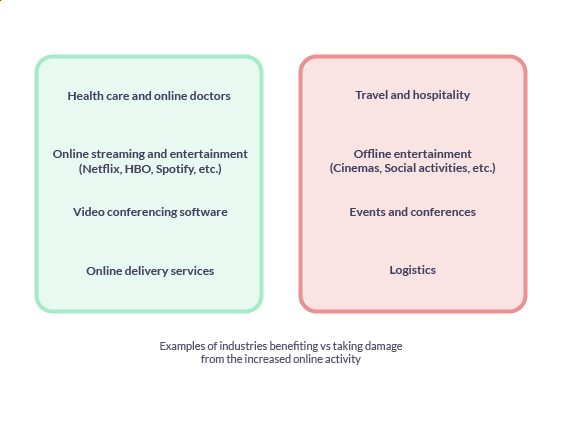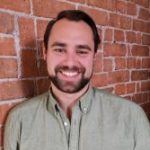How the coronavirus is affecting the digital advertising ecosystem
The new coronavirus is spreading and governments around the world are trying to contain the virus by closing schools, public spaces, and borders. Physical events such as business conferences, sporting events, and concerts have been canceled and global markets are in free fall.
An increasing number of companies, such as Unilever, Spotify, and Google, are encouraging employees to work from home. This has led to a change in lifestyle where consumers have shifted to spending more time online than before.
Brands already catering to the ‘sofa-surfers’ will most likely not be in too much trouble and might even see an increase in sales. Brands that are traditionally offline will likely innovate new online products in an effort to adapt to this new way of living.
The most important factor of the pandemic is obviously the health of the population, but there are far more people affected than merely the sick.
Businesses are feeling the effects of the virus and companies are announcing cutbacks one after another. Marketing departments around the world are noticing the effects as well.
Most marketers are at a crossroad, wondering which path to take in such an uncertain future. This article goes through how marketers are adapting to these new circumstances and what you should keep in mind while getting through this pandemic.
How marketers are responding
- Short-term adaptations
Recent research has shown that 61% of marketers are altering their short-term media strategy. However, only 9% are making long-term changes.
There is a slight move from offline media to online, as marketers in the same study made clear that they would take a more online approach.
This budget shift is not surprising considering that digital media is consumed at a higher rate due to the online lifestyle of the post-corona consumer.
Moving to flexible channels
Marketers seeing a cut in budgets will benefit by moving toward cheaper and more flexible channels such as programmatic advertising where consumer presence and available impressions are increasing.
Digital display ads, social media, and online video are channels that most likely will increase in the short-term media plan.
Out-of-home advertising such as metro billboards will have much lower exposure due to most people staying at home. Event marketing has come to an immediate stop, and we’ll likely see that marketing budget cease or shift towards online ads.
However, not everyone sees marketing budget cuts as the solution.
Some B2B brands are increasing digital advertising spend to compensate for the leads they otherwise would have picked up at events.
- Long-term concern
An existing concern is that no one really knows when the pandemic is over and everyone can go back to their regular lives.
We are seeing how spend is decreasing in certain industries such as the travel sector, retail, or events, however, many on-demand online services will likely increase advertising spend – especially in online channels. Services such as online food delivery services, streaming or online news outlets are benefiting from the higher online presence and will want to take a larger market share in a larger market and increase spend.
What to keep in mind during the pandemic
- This too shall pass
The uncertainty of the future is understandable. Nonetheless, this too shall pass.
It is important to stay focused on the long-term and not shy away from new growth opportunities. Branding is best worked long-term, cutting budget spend too much when not necessary could negatively impact the brand when the pandemic is over. Marketers should not forget that in the midst of a crisis – there could be opportunity.
“… be ready for the recovery – prepare now for campaigns to reflect the optimism, for popped-up and expanded physical availability to capture resurgence of demand, and ready your promotions and incentives to capture a share of sales when they recover. But above all understand that weathering and not just surviving, but thriving, through change is what we all do now. That’s all our new normal, and has been for a while.”
– Chris Stephenson, regional head of strategy and planning, PHD APAC
- Seize the opportunities
This is a new time for everyone, not to mention the consumers.
Since many work from home and stay indoors much more now than just recently, we will see a new type of online behaviour.
Consumers will be online at times which marketers may not be used to. Online activity and shopping could shift to mid-day, when activity in normal circumstances is low.
Online activity could also be higher since there is a constant stream of breaking news.
Media will be cheaper as marketing budgets in certain industries are cut, if there is a possibility, capitalising on this will have clear positive effects on share-of-voice.
- Digital opportunities
With many affected companies decreasing their marketing budgets, we will most likely see a sharp drop in CPM and CPC prices (due to a decline in competition). This is an ideal opportunity for some marketers to acquire new customers at a lower cost than previously.
Consumers spend more time reading or watching the news than ever before. Marketers now have the opportunity to capture more eye-balls by advertising on these popular websites, at a lower cost than the pre-corona period.
- Adapt to the new customer
For a brand, being online has never been as important as today.
Try to treat your daily work as business as usual, but keep it digital.
Locate your target audience and how their lifestyle has changed and map out how you should be targeting them.
What is your target audience’s emotional context? What do they want to hear? How should you be communicating with them?
Do not underestimate how the coronavirus has changed your customers and how it has affected their demands.
Conclusion
There is no doubt that the coronavirus has left its mark in history – the question is rather how much things will change.
We have now seen the effects on different industries and marketing efforts, but how will marketers adjust? More digital solutions need to be considered for all industries. Webinars, digital entertainment and virtual doctor visits are examples of solutions to come when physical contact is restricted.
Even during a time that feels like a downward spiral – there can be an opportunity to be seized.
 Jonathan Olsson is a Marketing Manager at Match2One based in Stockholm, Sweden. Match2One is a leading programmatic buying platform, helping marketing teams save time and increase performance with AI-powered solutions. Match2One has helped thousands of companies across 50+ countries to grow with smarter display advertising solutions.
Jonathan Olsson is a Marketing Manager at Match2One based in Stockholm, Sweden. Match2One is a leading programmatic buying platform, helping marketing teams save time and increase performance with AI-powered solutions. Match2One has helped thousands of companies across 50+ countries to grow with smarter display advertising solutions.
Uutiskirjeen tilaajana saat markkinoinnin ja viestinnän uutiset sekä uusimman MRKTNG-lehden ensimmäisten joukossa. Saat myös viikottain koulutuksistamme kerättyjä vinkkejä käyttöösi sekä tietoa järjestämistämme koulutuksista.
